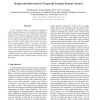Free Online Productivity Tools
i2Speak
i2Symbol
i2OCR
iTex2Img
iWeb2Print
iWeb2Shot
i2Type
iPdf2Split
iPdf2Merge
i2Bopomofo
i2Arabic
i2Style
i2Image
i2PDF
iLatex2Rtf
Sci2ools
110
click to vote
WACV
2008
IEEE
2008
IEEE
Background Subtraction for Temporally Irregular Dynamic Textures
In the traditional mixture of Gaussians background model, the generating process of each pixel is modeled as a mixture of Gaussians over color. Unfortunately, this model performs poorly when the background consists of dynamic textures such as trees waving in the wind and rippling water. To address this deficiency, researchers have recently looked to more complex and/or less compact representations of the background process. We propose a generalization of the MoG model that handles dynamic textures. In the context of background modeling, we achieve better, more accurate segmentations than the competing methods, using a model whose complexity grows with the underlying complexity of the scene (as any good model should), rather than the amount of time required to observe all aspects of the texture.
Related Content
| Added | 01 Jun 2010 |
| Updated | 01 Jun 2010 |
| Type | Conference |
| Year | 2008 |
| Where | WACV |
| Authors | Gerald Dalley, Joshua Migdal, W. Eric L. Grimson |
Comments (0)

